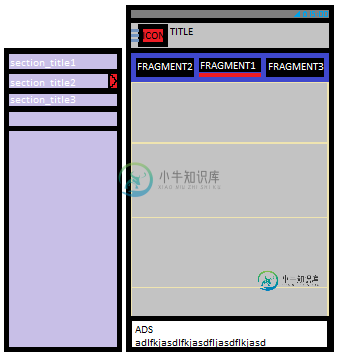如何从导航抽屉中打开一个新的片段?
我正在使用developer.android.com指南来构建一个应用程序。我在Android Studio做新项目时选择了“导航:导航抽屉”。我已经在互联网上搜索我的问题的答案,但我没有找到任何有效的。抱歉,我是编程新手。
- 在导航抽屉中单击时,如何使应用程序在主视图中打开一个新的片段?
- 在导航抽屉中单击时,是否可以使用选项卡打开多个可滑动的片段?
- 如何使“标题”可展开/可折叠?
http://developer.android.com/design/patterns/navigation-drawer.html http://developer.android.com/training/implementation-navigathtml" target="_blank">ion/nav-drawer.html

共有1个答案
导航抽屉是一个新的和趋势的设计这些天。在为导航抽屉活动设计xml.layout(layout)时,我们使用了两种布局:主要内容布局和抽屉列表布局。我在回答你所有愚蠢的问题。
我如何让我的app在导航抽屉中点击时在主视图中打开一个新的片段?
只需在抽屉列表项上添加clicklistener,并根据单击的列表项的位置替换主要内容中的片段。
// The click listener for ListView in the navigation drawer
@SuppressWarnings("unused")
private class DrawerItemClickListener implements ListView.OnItemClickListener {
@Override
public void onItemClick(AdapterView<?> parent, View view, int position, long id) {
selectItem(position);
}
}
private void selectItem(int position) {
Fragment newFragment;
FragmentTransaction transaction = getFragmentManager().beginTransaction();
switch (position) {
case 0:
newFragment = new f1();
transaction.replace(R.id.content_frame, newFragment);
transaction.addToBackStack(null);
transaction.commit();
break;
case 1:
newFragment = new f2();
transaction.replace(R.id.content_frame, newFragment);
transaction.addToBackStack(null);
transaction.commit();
break;
case 2:
newFragment = new f3();
transaction.replace(R.id.content_frame, newFragment);
transaction.addToBackStack(null);
transaction.commit();
break;
case 3:
newFragment = new f4();
transaction.replace(R.id.content_frame, newFragment);
transaction.addToBackStack(null);
transaction.commit();
break;
}
//DrawerList.setItemChecked(position, true);
setTitle(ListTitles[position]);
DrawerLayout.closeDrawer(DrawerList);
}
为了在片段内实现选项卡,您可以在该特定片段内使用tabhost。假设您希望在片段f_main中添加选项卡。
f_main.xml的布局
<TabHost
xmlns:android="http://schemas.android.com/apk/res/android"
android:id="@android:id/tabhost"
android:layout_width="match_parent"
android:layout_height="match_parent" >
<LinearLayout
android:layout_width="match_parent"
android:layout_height="match_parent"
android:orientation="vertical" >
<TabWidget
android:id="@android:id/tabs"
android:layout_width="match_parent"
android:layout_height="wrap_content"
android:layout_weight="0"
android:orientation="horizontal" />
<FrameLayout
android:id="@+id/tabFrameLayout"
android:layout_width="match_parent"
android:layout_height="0dp"
android:layout_weight="1" />
</LinearLayout>
</TabHost>
然后制作其他片段f_tab1和f_tab2及其相应的布局和java类。两个选项卡片段的布局可以相同或不同。在这里,我采取相同的或一个共同的布局。
<?xml version="1.0" encoding="utf-8"?>
<LinearLayout xmlns:android="http://schemas.android.com/apk/res/android"
android:layout_width="match_parent"
android:layout_height="match_parent"
android:orientation="vertical" >
<TextView android:id="@+id/google_map"
android:layout_height="wrap_content"
android:layout_width="match_parent"
android:text="MAP"/>
</LinearLayout>
import android.os.Bundle;
import android.support.v4.app.Fragment;
import android.view.LayoutInflater;
import android.view.View;
import android.view.ViewGroup;
public class F_tab1 extends Fragment {
@Override
public View onCreateView(LayoutInflater inflater, ViewGroup container,
Bundle savedInstanceState) {
View view=inflater.inflate(R.layout.friends_list, container,false);
return view;
}
}
import android.os.Bundle;
import android.support.v4.app.Fragment;
import android.view.LayoutInflater;
import android.view.View;
import android.view.ViewGroup;
public class F_tab2 extends Fragment {
@Override
public View onCreateView(LayoutInflater inflater, ViewGroup container,
Bundle savedInstanceState) {
View view=inflater.inflate(R.layout.friends_list, container,false);
return view;
}
}
我不知道NV抽屉是否提供了这个功能。但它提供了一个功能,可以根据选定的抽屉项或加载的主要内容片段来切换操作栏标题。
正如导航抽屉设计指南中所讨论的,当抽屉可见时,您应该修改操作栏的内容,例如更改标题和删除与主要内容相关的操作项。下面的代码演示了如何通过使用ActionBarDrawerToggle类的实例重写DrawerLayout.DrawerListener回调方法来实现此目的,如下所示
public class MainActivity extends Activity {
private DrawerLayout mDrawerLayout;
private ActionBarDrawerToggle mDrawerToggle;
private CharSequence mDrawerTitle;
private CharSequence mTitle;
...
@Override
public void onCreate(Bundle savedInstanceState) {
super.onCreate(savedInstanceState);
setContentView(R.layout.activity_main);
...
mTitle = mDrawerTitle = getTitle();
mDrawerLayout = (DrawerLayout) findViewById(R.id.drawer_layout);
mDrawerToggle = new ActionBarDrawerToggle(this, mDrawerLayout,
R.drawable.ic_drawer, R.string.drawer_open, R.string.drawer_close) {
/** Called when a drawer has settled in a completely closed state. */
public void onDrawerClosed(View view) {
getActionBar().setTitle(mTitle);
invalidateOptionsMenu(); // creates call to onPrepareOptionsMenu()
}
/** Called when a drawer has settled in a completely open state. */
public void onDrawerOpened(View drawerView) {
getActionBar().setTitle(mDrawerTitle);
invalidateOptionsMenu(); // creates call to onPrepareOptionsMenu()
}
};
// Set the drawer toggle as the DrawerListener
mDrawerLayout.setDrawerListener(mDrawerToggle);
}
/* Called whenever we call invalidateOptionsMenu() */
@Override
public boolean onPrepareOptionsMenu(Menu menu) {
// If the nav drawer is open, hide action items related to the content view
boolean drawerOpen = mDrawerLayout.isDrawerOpen(mDrawerList);
menu.findItem(R.id.action_websearch).setVisible(!drawerOpen);
return super.onPrepareOptionsMenu(menu);
}
}
-
我已经搜索了这个,还没有找到答案,我使用Android导航抽屉模板,当从导航菜单点击时,我有一些片段相互替换,当应用程序第一次打开时,它在Content_Main布局上打开,当我点击我的一个片段时,它打开了,但Content_Main的内容仍然显示,我需要隐藏,而我使用其他片段,也做了一个主页按钮,让我从菜单上回到这个内容,有什么帮助吗? 问题是当我打开应用程序时,Content_main布局出现
-
所以我有一个活动,其中有一个片段,片段有一个导航抽屉和页面的内容。当我打开抽屉并单击一个项目时,片段被替换为一个新片段。当我按下后退按钮时,我在片段管理器上调用popBackStack,它返回到第一个片段,但导航抽屉是打开的。 有几件事要注意:当按下抽屉中的一个项目时,我在抽屉布局上调用关闭抽屉,当片段被替换时抽屉关闭。如果我按下操作栏中的UP按钮,我可以用新的主片段替换片段容器,但我更喜欢能够将
-
我已经创建了默认的Android Studio导航抽屉项目。默认情况下,我有一个活动和三个主要片段。(家庭,画廊,幻灯片),我只是尝试与家庭片段。我已经将 从content_main XML替换为 并将MainActivity修改为
-
我想从右到左像图片一样打开
-
首先,我知道这个问题以前在这里出现过,但试了很多,还是没有成功。我在Android开发者网站上做这个例子。 你能帮我弄清楚我的代码中的问题是什么,为了设置菜单从右边打开,以及为了将操作栏按钮移到右边,我应该做些什么改变吗? xml代码如下所示:

